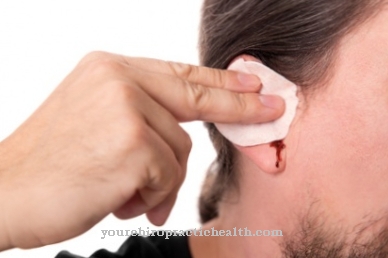Heel pain have many possible causes. An early visit to the doctor and the associated early start of treatment are important for successful therapy.
What is heel pain?

Heel pain can affect different areas of the human heel. In most cases, heel pain manifests itself in a comparatively characteristic way: The corresponding pain occurs primarily as so-called start-up pain. A start-up pain is characterized by the fact that it takes on its strongest form when the foot is put under pressure after longer periods of rest; for example when you get up in the morning.
Athletes in particular are occasionally affected by heel pain. Depending on the period for which heel pain is already present in a person affected, a distinction can be made between acute and chronic heel pain: Chronic heel pain is pain that has already been evident over several months.
causes
Possible causes of heel pain are very diverse. In many cases, the pain is caused by impairment of the Achilles tendon (the end tendon of the calf muscle and the strongest human tendon). For example, inflammation, but also overloading or tears in the Achilles tendon can lead to heel pain.
Other possible causes of heel pain are also inflammatory processes in the bursa on the heel. A so-called fatigue fracture (a fracture caused by long-term overload) of the calcaneus can also be the cause of heel pain.
Heel pain can also be caused by a strong breakdown of the heel fat pad; the bony structures of the heel are no longer adequately protected against vibrations. If a patient has what is known as a heel spur (i.e. a thorn-like bone outgrowth), this can also cause heel pain.
Degenerative processes (often age-related) on the heel can also be painful. In some cases, heel pain is also an early symptom of chronic diseases, such as ankylosing spondylitis (an autoimmune disease that can lead to a curvature of the spine over time).
Diseases with this symptom
- Achillodynia
- ankylosing spondylitis
- Heel spur
- Fatigue fracture
- gout
- Achilles tendon tear
- rheumatism
- Tarsal tunnel syndrome
- Achilles tendonitis
- Spinal curvature
- Bursitis
- Circulatory disorders
Diagnosis & course
To diagnose the causes of heel pain, the doctor usually first asks about the patient's medical history. This medical history includes, for example, previous illnesses or injuries with possible effects on structures of the heel.
During a subsequent physical examination for heel pain, factors such as posture, joint mobility, reflexes, muscle strength or gait are often assessed. In order to be able to visualize the inner heel structures in the case of heel pain, diagnostic procedures such as ultrasound or X-rays are carried out if necessary.
The course of heel pain mainly depends on the cause of the pain. If the causes of heel pain can be remedied medically or through the body's self-healing powers, the pain usually also subsides. If heel pain is based on long-term illnesses, the course of the pain is usually related to the course of the underlying disease.
Complications
If heel pain occurs, there may be restrictions in daily mobility, which lead to a strong reduction in the personal range of motion. The way you walk can also change. In the following this leads to a loss of balance and an increased risk of falls and accidents.
It is also known that heel pain is one of the most common causes of hindfoot problems, which often pose a particular therapeutic challenge. In addition, there are reports of complaints from restricted dorsiflexion of the foot. Especially when this is reduced to less than 10 degrees.
If there is plantar fasciitis (the tendon plate of the sole of the foot is inflamed) due to excessive strain, heel pain results from strain and pressure. If this inflammation is not treated in a timely manner, it can become chronic. If the heel pain is due to a heel spur, the adjacent soft tissue may become inflamed.
If the treatment is carried out with an open notch performed surgically, the pain may persist afterwards, recur after a short period of freedom from symptoms (relapse pain) or extend to the metatarsus. In addition, there are the normal surgical risks such as infections, painful scars or venous thrombosis. Embolisms and nerve injuries are also very rare, but cannot generally be ruled out. The fact that there is an over- or undercorrection or, in the end, a missing attachment of the Achilles tendon attachment after the reconstruction, cannot be ruled out as a complication, but it is extremely rare.
When should you go to the doctor?
Doctors call heel pain a potpourri of different forms of pain in the heel. In addition to malpositions of the feet, these include bone and nerve problems as well as heel spurs and defects in the Achilles tendon or bursa. As diverse as the causes of heel pain is how those affected deal with it. Some see it as a triviality at first, others are already afraid of an operation. Neither is the best attitude towards heel pain. Visiting a doctor, on the other hand, is an excellent idea.
Heel pain should be treated by a specialist, preferably an orthopedic surgeon. When researching the cause, he will ask exactly the right questions and expertly scan the foot for pressure pain and swelling. In this way, misaligned feet, poorly fitting shoes, one-sided loads, but also overweight can be exposed as possible causes of heel pain.
Many orthopedic surgeons complain that their patients often come to them late, when the heel pain has already progressed. The longer the treatment of heel pain will take. This test of patience and an unnecessarily long period of suffering is spared anyone who goes to a doctor right away with heel pain. A surgeon rarely needs to be consulted in the event of heel pain, especially if the doctor's visit takes place early. A foot is a complicated structure with a demanding task. A healthy heel is an important part of his foundation.
Doctors & therapists in your area
Treatment & Therapy
Therapeutic measures for heel pain can take two different forms: While a causal treatment combats the causes of the corresponding pain, symptomatic therapy is used, for example, to relieve acute pain. Often both forms of therapy are combined in the treatment of heel pain.
Cause therapy for heel pain is always based on the individual cause: If heel pain is based on a heel spur, treatment is usually conservative (without surgical procedures). For example, the influence of vibrating tuning forks on the affected heel can lead to the calcification of a heel spur loosening and the spur receding.
A parallel pain treatment of heel pain in the heel spur can be done, for example, through local cold applications, shock wave treatments or pain-relieving medication that is injected locally. If the Achilles tendon is partially or completely torn as the cause of heel pain, healing can be supported by a special shoe that slightly elevates and immobilizes the affected foot.
In some cases, it may be necessary to correct the cause by surgery to treat heel pain. If the underlying disease is present, consistent treatment of this disease often also has a positive effect on the heel pain caused.
Outlook & forecast
It is relatively difficult to make the prospect or an exact prognosis for heel pain, as the cause of this pain must first be clarified. If it is a heel spur, you can expect very unpleasant pain when walking or standing. If there is a physical or unusual overload, such a heel spur develops.
When starting up and with other loads, persistent pain occurs, which is perceived very intensively by the person concerned. If this clinical picture is left untreated, a heel spur will persist. Especially if the overload continues, no improvement is to be expected. Heel spurs can only be completely cured with appropriate treatment and a longer break.
However, if the heel pain is caused by a fracture, medical treatment is essential. If a fracture remains completely untreated, there is a risk of severe inflammation, which in the worst case can even cause blood poisoning. Of course, with appropriate treatment and care, a fracture can be completely healed within a few weeks. Immobilizing the respective foot accelerates the entire healing process.
prevention
Heel pain as a result of a long-term illness can be prevented primarily through consistent therapy of the underlying illness. Heel pain as a result of physical overload can, for example, prevent a warm-up before exercise and an individually tailored training program. Heel pain as a result of acute injuries can only be prevented to a limited extent.
You can do that yourself
Various measures help to relieve heel pain and prevent further pain. If patients with heel pain are overweight, they should reduce their body weight. A body weight in the normal range and a healthy metabolism is easy on the joints. Good blood circulation is important. A healthy and balanced diet, abstinence from nicotine and regular physical activity promote blood circulation and thus alleviate heel pain.
The feet should be cared for regularly. This includes suitable footwear in everyday life and for sports and in every season. Shoes and stockings should be changed daily. Breathing textiles are also recommended. Calluses from calluses can cause heel pain. If calluses are present, they should be rubbed off with a suitable file or pumice stone. A nourishing cream is also helpful. To make the skin more supple, a lukewarm foot bath with a little salt is helpful. Diabetics should never remove calluses themselves, but rather take professional foot care.
Walking barefoot is healthy and can relieve heel pain, provided that there are no foot problems or increased risks, for example for diabetics. In sports halls, swimming pools and saunas, however, walking barefoot is not recommended. Exercise is recommended for patients with heel pain. Special foot exercises help strengthen the arches of the foot and stretch tendons and muscles.

.jpg)






.jpg)



















